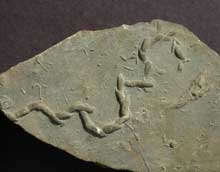University of California, Riverside study dates our ancestors

Photo Caption: A type of branching burrow system that first appear at the base of the Cambrian (circa 545 million years before the present). The trace consists of a series of curved open tunnels that extended into the muddy sea floor. The tunnels were later filled with sand and the mud weathered away resulting in a cast of burrow system. The producer of this trace fossil is not known but these trace fossil nevertheless are important in that they mark the beginning of the sea floor being churned by sediment processing animals. Compared to the much simpler trace fossils in older rocks they also bear witness to the appearance of more complex animal behavior. The figured specimen is from the Lower Cambrian of Sweden. The length of each curved element is about 7 mm. <br>
Study suggests macroscopic bilaterian animals did not appear until 555 million years ago
The traces left behind by ancient animals may hold the key to determining when macroscopic bilaterians — animals that are symmetric about a central axis, with a body divided into equivalent right and left halves, and with an anterior-posterior polarity (e.g., this includes worms, ants, and ranging up to humans) — first appeared. A team led by Dr. Mary Droser, professor of geology at the University of California, Riverside, studied “trace” fossils, e.g., burrows, trails and tracks left behind by the earliest bilaterian animals. Results from their study suggest that bilaterian animals did not appear until approximately 555 million years ago.
The authors publish their findings in a paper entitled “Trace fossils and substrates of the terminal Proterozoic-Cambrian transition: Implications for the record of early bilaterians and sediment mixing” in the Proceedings of the National Academy of Sciences (PNAS). They report that these trace fossils, found in many different locations around the world, were preserved very well in sediment beds from the Early Cambrian (544 to 510 million years ago), both in terms of quality of detail and in preserving traces made close to this sediment-water interface. Trace fossils can shed light on an organism’s behavioral activity.
“The timing of the appearance of bilaterian animals, while clearly by 555 million years ago, is the subject of some debate,” said Droser. “One of the most important pieces of evidence for early animals is the record of trace fossils. That is, animal burrows, tracks and trails preserved in the rock record. Based on evidence from functional morphology, many of the features that define bilaterians could only have originated in a relatively large animal that inhabited the seafloor and thus produced trace fossils. Early bilaterians, in particular, were soft-bodied and thus difficult to preserve.”
The trace fossils examined in the study are from the transition between the Proterozoic Era (2.5 billion to 544 million years ago), where few animal body fossils are found, and the Cambrian (544 to 490 million years ago), where diverse animal body fossils such as trilobites are found. Proterozoic trace fossils, typically only a few millimeters wide, are found at the interface between water and sediment. The Cambrian trace fossils are more diverse in size, shape and depth of penetration into the sediment.
The researchers examined and did field work on thousands of meters of rock. “We collected samples from Australia, Newfoundland, the western United States, Scandinavia and Namibia,” said Soren Jensen, co-author of the PNAS paper and a postdoctoral researcher in the department of earth sciences at UC Riverside. “These samples of ancient marine rocks were then carefully inspected, x-rayed, and thin-sectioned for microscopic examination to provide us with an even closer look.”
The authors attribute the exceptional preservation of Early Cambrian trace fossils to the low levels of sediment mixing, which resulted in relatively firm substrates less prone to resuspension. Close inspection of these fossils could help determine exactly when bilaterian animals emerged, a topic of much controversy.
“There have been reports of trace fossils as old as 1 billion years old,” said Droser. “But these records are scarce and, on critical examination, are not convincing. On examining the trace fossil record from 565 million years ago through until 535 million years ago, we found that the substrate conditions — for example, the bottom of the ocean — were such that if animals were burrowing or walking or crawling along the seafloor, their traces would have likely been preserved. We see a gradual increase in diversity and complexity of trace fossils from about 555 million years ago, known as the Cambrian Explosion and which likely reflects the appearance of bilaterians. We found no evidence for a long history of large animals before this time.”
News Media Contact:
Name: Iqbal Pittalwala
Phone: 909.787.2645
Email: iqbal@citrus.ucr.edu
Media Contact
All latest news from the category: Earth Sciences
Earth Sciences (also referred to as Geosciences), which deals with basic issues surrounding our planet, plays a vital role in the area of energy and raw materials supply.
Earth Sciences comprises subjects such as geology, geography, geological informatics, paleontology, mineralogy, petrography, crystallography, geophysics, geodesy, glaciology, cartography, photogrammetry, meteorology and seismology, early-warning systems, earthquake research and polar research.
Newest articles

NTU and NUS spin-off cutting-edge quantum control technology
AQSolotl’s quantum controller is designed to be adaptable, scalable and cost-efficient. Quantum technology jointly developed at Nanyang Technological University, Singapore (NTU Singapore) and National University of Singapore (NUS) has now…

How Geothermal Energy Shapes Bavaria’s Green Future Through Sustainable Energy
The Bavarian State Ministry of Science and the Arts has extended its funding for the research association “Geothermal Alliance Bavaria,” with the University of Bayreuth (UBT) continuing as a member…

Spintronics memory innovation: A new perpendicular magnetized film
Long gone are the days where all our data could fit on a two-megabyte floppy disk. In today’s information-based society, the increasing volume of information being handled demands that we…



